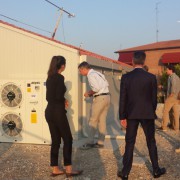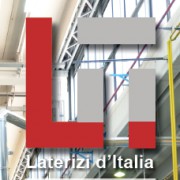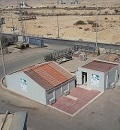Study Visit
/in News /da Silvia ZambelliCOMSOL CONFERENCE 2016 – Munich
/in News /da Silvia ZambelliThe design of a novel roof tile shape using CFD analysis
Michele Bottarelli*1,Marco Bortoloni1, Giuseppe Dino1
1University of Ferrara, Department of Architecture, Italy
*corresponding author: [email protected]
In climates with high temperature and solar radiation, reducing the cooling consumption and increasing the standards of indoor comfort are topics of great importance. The roof plays a key role in controlling the indoor thermal comfort, due to its size in comparison with the other components of a building envelope and the direct exposure to solar radiation. The arrangement of the covering elements on a battens and counter-battens system allows creating a ventilation layer under the tiles in the tiled pitched roof. This so-called Above Sheathing Ventilation (ASV) helps to dissipate the excess heat during the summer, reducing the heat transfer between tiles and roof structure below, thereby also reducing the cooling energy requirement. In ventilated roofs, air flow within the ASV depends on the air entering and leaving at the eaves and the ridge, according to external wind conditions. Moreover, in tiled roofs the air-permeability of the overlapping tiles is an additional and diffuse intake/exhaust air-vent system therefore, the benefits of ASV could be enhanced by increasing the roof air permeability by means of novel tile shapes. That is the main idea of the HEROTILE European project (LIFE14 CCA/IT/000939), of which this work presents the preliminary analysis supporting the design of new tiles.
In this study, in order to support the design of novel Marseillaise tile shapes, the air permeability of newly designed tile was compared with that of the reference tile, under different wind directions and intensities. The reference tile shapes as well as the novel one were imported in COMSOL Multiphysics from CAD drawings by means of the CAD Import Module. The CFD Module of COMSOL Multiphysics was used to simulate the airflow through the tiles, solving the steady-state, incompressible, turbulent fluid dynamic problem in a three dimensional domain by means of the RANS-based standard k-e model. A parametric study was conducted to analyse the air flow variation in a ventilated pitched roof: four incident wind velocities (0.5, 1.0, 2.0, 5.0m/s) were considered, with three vertical (10°, 20°, 30°) and six horizontal inclinations (0°, 15°, 30°, 45°, 60°, 80°). Overall, 72 wind conditions over a simplified pitched roof were simulated.
The reference and new tile designs were compared in terms of the air pressure drop and the volumetric flow rate trough tiles. Preliminary results showed that new Marseillaise shape produced a small improvement in the air permeability and that some solutions were less affected by the wind direction. A flow rate increase through the novel shaped tiles was related to both the enlarged open area between the tiles and the original design of the head lock. In view of this, the head lock design was further improved, yielding an increase in air permeability of up to 100% in comparison with the standard designs. Therefore, both these aspects should be considered in designing a novel Marseillaise tile shape. Moreover, contrary to the standard shape, the final design showed an increase in the air flow rate as the wind blows sideways.









